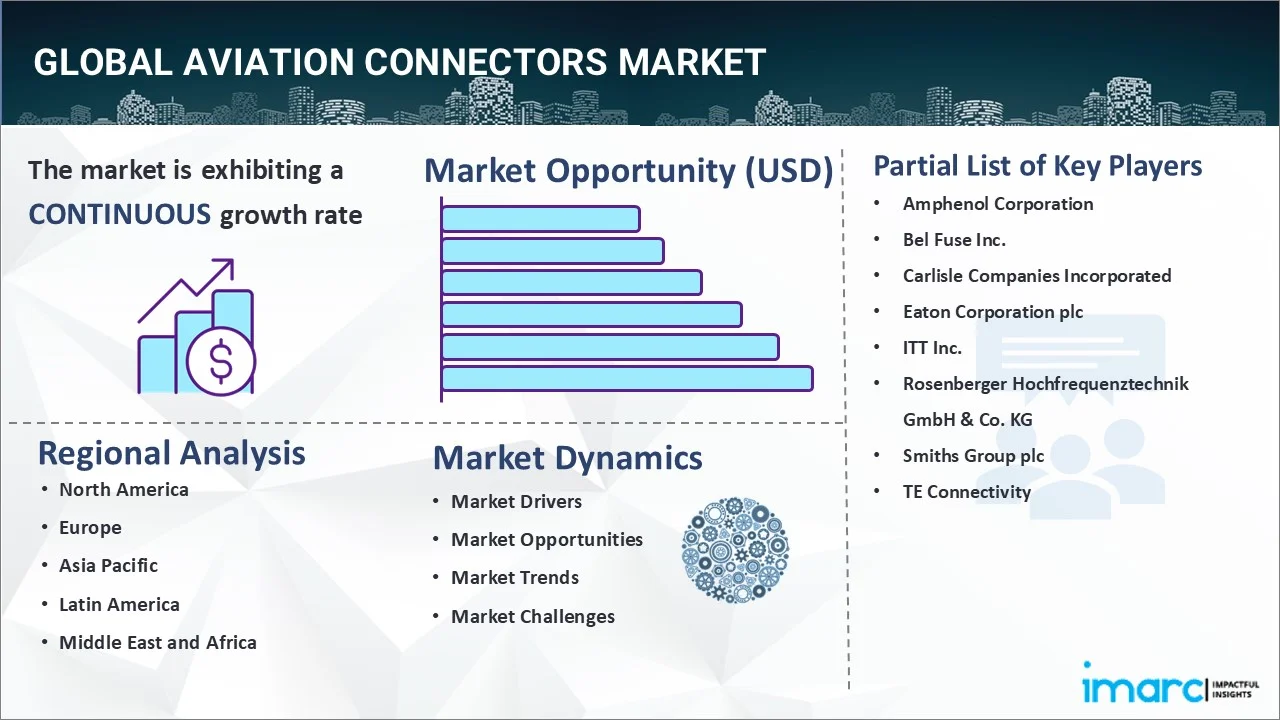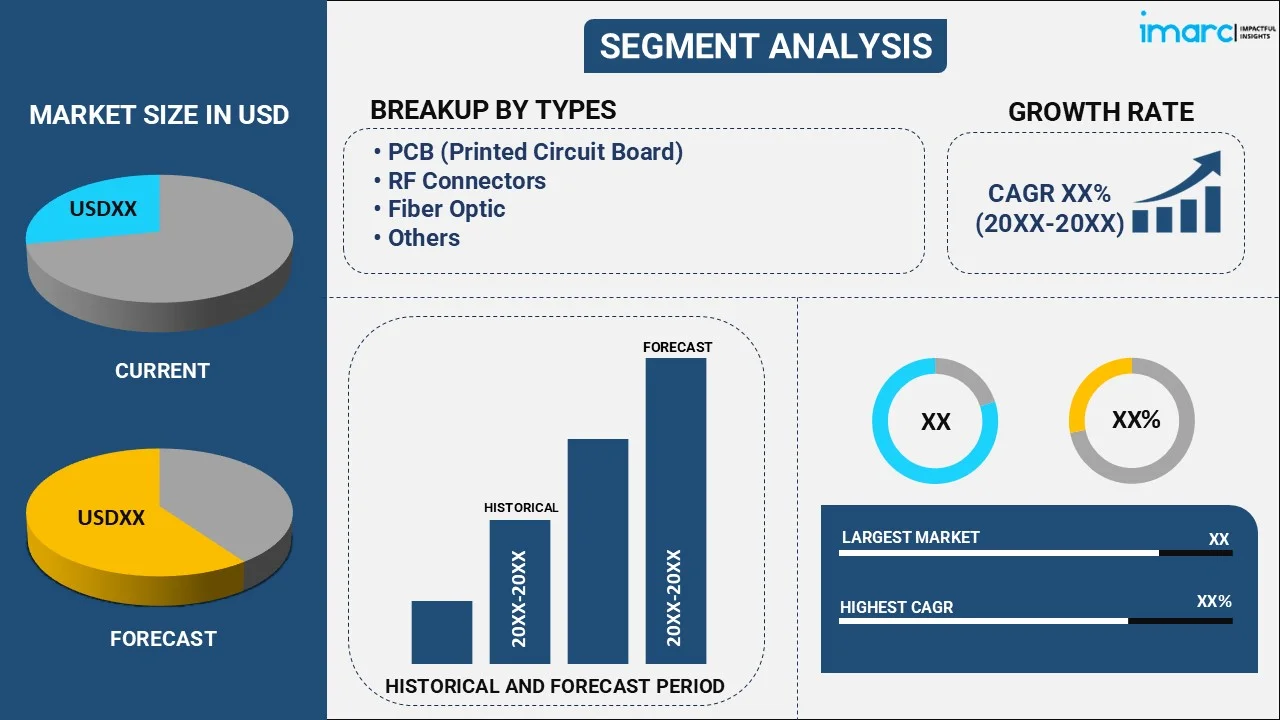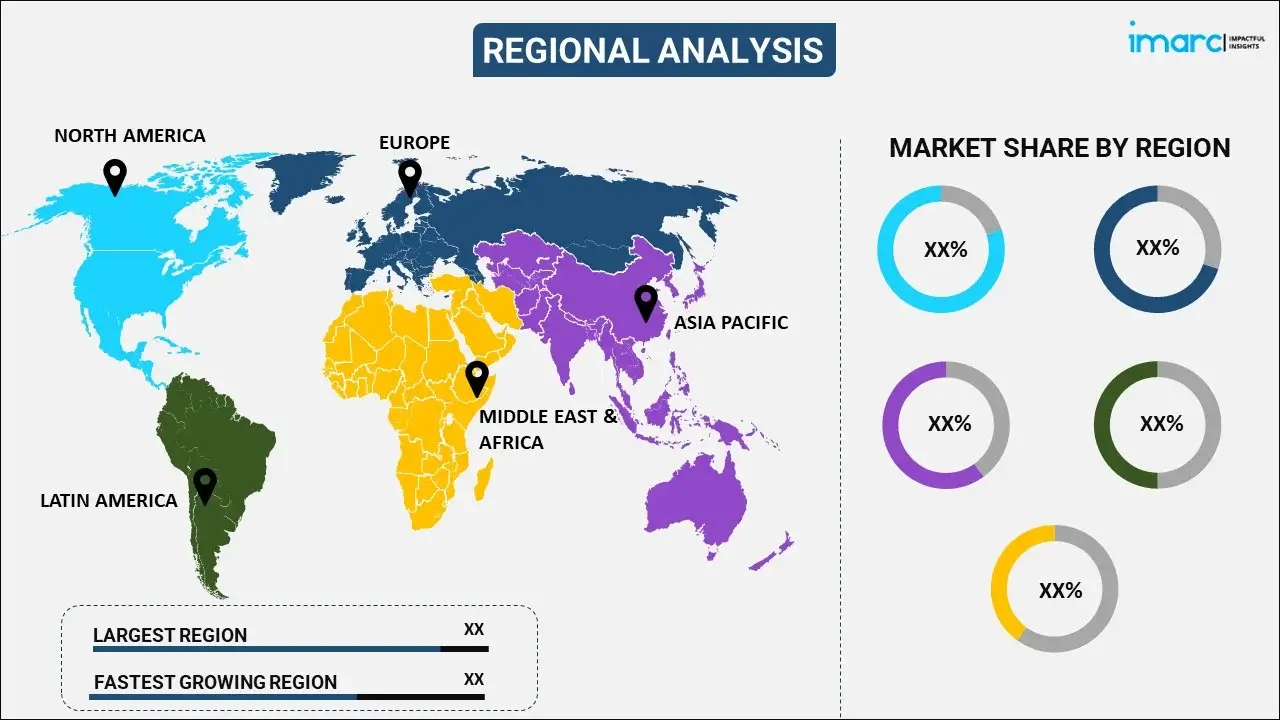
Aviation Connectors Market Report by Type (PCB (Printed Circuit Board), RF Connectors, Fiber Optic, and Others), Shape (Circular, Rectangular), End User (Military, Commercial, Business Jets, and Others), and Region 2025-2033
Market Overview:
The global aviation connectors market size reached USD 6.3 Billion in 2024. Looking forward, IMARC Group expects the market to reach USD 9.8 Billion by 2033, exhibiting a growth rate (CAGR) of 4.58% during 2025-2033. The ongoing digital transformation in the aviation industry, rising demand for unmanned aerial vehicles (UAVs) for commercial and military applications, and the increasing shift towards electric and hybrid-electric propulsion systems in aircraft are some of the major factors propelling the market.
|
Report Attribute
|
Key Statistics
|
|---|---|
|
Base Year
|
2024 |
|
Forecast Years
|
2025-2033
|
|
Historical Years
|
2019-2024
|
| Market Size in 2024 | USD 6.3 Billion |
| Market Forecast in 2033 | USD 9.8 Billion |
| Market Growth Rate 2025-2033 |
4.58%
|
Aviation connectors, also known as aerospace connectors or aeronautical connectors, are high-performance, reliable components used for connecting electrical circuits within aircraft and aerospace systems. These connectors are designed to withstand extreme conditions, such as high vibration, wide temperature ranges, and high pressure, which help ensure the safety and efficiency of aviation operations. They are lightweight and compact to fit within the limited space and weight parameters of aircraft. They maintain the integrity of the connection under strenuous flight conditions. They help in the transmission of vital signals for engine monitoring and control. Besides this, they are used in the communication systems of airplanes to facilitate clear and reliable transmission of voice and data signals.

The ongoing digital transformation in the aviation industry is catalyzing the need for efficient data connectors. Additionally, the introduction of 5G in aviation is driving the need for upgrades in connector technology to handle higher data speeds. Further, manufacturers are increasingly implementing Industry 4.0 practices, which require advanced connectors for machine-to-machine communication. Apart from this, the demand for unmanned aerial vehicles (UAVs), for commercial and military applications, is stimulating the need for reliable connectors. The growing emphasis on data security in aviation communication systems is also supporting the development of connectors with enhanced security features. Furthermore, the shift towards electric and hybrid-electric propulsion systems in aircraft is opening up new opportunities for specialized connectors in the sector.
Aviation Connectors Market Trends/Drivers:
The introduction of advanced technologies
Rapid technological advancement in the aerospace industry represents one of the key factors positively influencing the market. Additionally, as aircraft systems are becoming more advanced and sophisticated, the demand for complex and efficient connectors to ensure seamless operation is increasing. Apart from this, innovations in communication, navigation, and control systems are catalyzing the demand for high-performance, reliable, and durable aviation connectors. Furthermore, advancements in in-flight entertainment systems, including high-definition video streaming, are increasing the need for connectors capable of high-speed data transmission. Moreover, the rising trend of miniaturization in electronic systems is driving the requirement for more compact and lighter connectors.
The implementation of stringent safety standards and regulations
The governing authorities of various countries are imposing strict safety standards to mandate the regular inspection and replacement of connectors, which is creating a constant demand for these components. Regulatory bodies like the Federal Aviation Administration (FAA) in the U.S. and the European Union Aviation Safety Agency (EASA) in Europe are enforcing stringent rules and guidelines to ensure the safety and performance of aviation connectors. Furthermore, the increasing requirement for consistent inspection is creating an ongoing demand for aviation connectors as these components need regular replacement following an inspection. Such practices help maintain the highest possible safety levels of aircraft.
Rise in air traffic
The increasing volume of air traffic across the globe is among the key factors favoring the market growth. Additionally, inflating income levels of individuals is resulting in a significant increase in the demand for air travel. This rise in air traffic is increasing the number of aircraft being manufactured, which, in turn, is catalyzing the demand for aviation connectors. Moreover, the increasing frequency of flights is driving the need for regular maintenance and part replacement, which is offering a favorable market outlook. Moreover, the rising need for cargo flights on account of the burgeoning e-commerce sector and rising international trade is positively influencing the market.
Aviation Connectors Industry Segmentation:
IMARC Group provides an analysis of the key trends in each segment of the global aviation connectors market report, along with forecasts at the global, regional, and country levels for 2025-2033. Our report has categorized the market based on type, shape, and end user.
Breakup by Type:

- PCB (Printed Circuit Board)
- RF Connectors
- Fiber Optic
- Others
Fiber optic dominates the market
The report has provided a detailed breakup and analysis of the market based on the type. This includes PCB (printed circuit board), RF connectors, fiber optic, and others. According to the report, fiber optic represented the largest segment. The increasing reliance of aviation industry on digital technologies and high-speed data transmission is catalyzing the demand for fiber optic connectors. Additionally, these connectors are increasingly being adopted in modern aircraft due to their ability to transmit large volumes of data over long distances with minimal signal loss.
The trend of miniaturization in aviation electronics is driving the demand for these connectors, as they can support compact and lightweight designs. PCB connectors are widely used in the aviation industry due to their ability to facilitate efficient electrical and electronic interconnections on PCBs. They are utilized in various aviation applications, such as flight controls, cockpit systems, and engine management.
Technological advancements in aviation communication systems are driving the demand for high-quality RF connectors. These connectors are used for transmitting radio frequency signals in aviation systems, particularly in communication, navigation, and radar systems.
Breakup by Shape:
- Circular
- Rectangular
Circular holds the largest share in the market
A detailed breakup and analysis of the market based on the shape has also been provided in the report. This includes circular and rectangular. According to the report, circular accounted for the largest market share. The increasing need for high-frequency signal transmission and power supply in modern aviation systems is catalyzing the demand for circular connectors as they are robust, highly durable, and reliable. They are designed to withstand harsh environmental conditions, such as high vibration, temperature fluctuations, and moisture.
The trend of miniaturization in aviation electronics is driving the demand for rectangular connectors, on account of their compact, streamlined design, which allows for a greater number of contacts in a smaller space, thus optimizing the use of space in avionics systems. Apart from this, rectangular connectors can be customized to fit numerous applications. This versatility allows them to be tailored to specific system requirements, including power, signal, and data needs, thereby increasing their demand in the aviation industry.
Breakup by End User:
- Military
- Commercial
- Business Jets
- Others
Commercial accounts for the majority of the market share
A detailed breakup and analysis of the market based on the end user has also been provided in the report. This includes military, commercial, business jets, and others. According to the report, commercial represents the largest market segment. The rising air passenger traffic and the trend of aircraft modernization are driving the need for efficient, reliable, and high-speed connectors in the commercial sector. Connectors are used for various systems like flight controls, engine management, in-flight entertainment, and communication in this sector.
Increasing investments in defense infrastructure and the procurement of advanced military aircraft globally are catalyzing the demand for reliable and high-performance aviation connectors in the military sector. Military aircraft require a robust set of connectors that can withstand extreme environments and offer high reliability. These connectors are utilized in a wide array of applications, such as communication, navigation, weapon systems, and surveillance.
The increasing corporate profits and the widespread adoption of these jets for business travel are fueling the demand for aviation connectors. Additionally, there is a rise in the demand for aviation connectors stems in business jets to cater to the growing need for reliable and high-speed data transfer, power supply, and signal transmission for various onboard systems.
Breakup by Region:

- North America
- United States
- Canada
- Europe
- Germany
- France
- United Kingdom
- Italy
- Spain
- Others
- Asia Pacific
- China
- Japan
- India
- South Korea
- Australia
- Indonesia
- Others
- Latin America
- Brazil
- Mexico
- Others
- Middle East and Africa
North America exhibits a clear dominance, accounting for the largest aviation connectors market share
The report has also provided a comprehensive analysis of all the major regional markets, which include North America (the United States and Canada); Europe (Germany, France, the United Kingdom, Italy, Spain, and others); Asia Pacific (China, Japan, India, South Korea, Australia, Indonesia, and others); Latin America (Brazil, Mexico, and others); and the Middle East and Africa. According to the report, North America accounted for the largest market share.
North America enjoys the leading position in the market as it houses key aircraft manufacturers, airlines, and defense contractors. The dense network of airports and frequent flight operations are driving the need for safety components. Apart from this, North America leads in aviation technology innovation. The continuous development and adoption of advanced avionics systems, including communication, navigation, surveillance, and flight management systems, are catalyzing the demand for sophisticated and high-performance connectors. Furthermore, the presence of stringent regulatory bodies like the Federal Aviation Administration (FAA), emphasizes safety and efficiency is resulting in the regular upgrading and replacement of aviation connectors.
Competitive Landscape:
Companies are investing in research and development (R&D) activities to develop new and improved aviation connectors that can meet the increasing demand for high-speed data transmission, withstand harsh environmental conditions, and comply with stringent safety standards. Additionally, some of them are focusing on merger and acquisitions (M&A) strategies to expand their product portfolios, gain access to new technologies, and enhance their market presence. Apart from this, many companies are working on optimizing their supply chains to ensure timely delivery of products, reduce costs, and improve overall operational efficiency. Moreover, they are providing robust customer service and technical support, including training clients on the use of their products, providing maintenance and repair services, and assisting with compliance and certification processes.
The report has provided a comprehensive analysis of the competitive landscape in the market. Detailed profiles of all major companies have also been provided. Some of the key players in the market include:
- Amphenol Corporation
- Bel Fuse Inc.
- Carlisle Companies Incorporated
- Eaton Corporation plc
- ITT Inc.
- Rosenberger Hochfrequenztechnik GmbH & Co. KG
- Smiths Group plc
- TE Connectivity
Aviation Connectors Market Report Scope:
| Report Features | Details |
|---|---|
| Base Year of the Analysis | 2024 |
| Historical Period | 2019-2024 |
| Forecast Period | 2025-2033 |
| Units | Billion USD |
| Scope of the Report | Exploration of Historical and Forecast Trends, Industry Catalysts and Challenges, Segment-Wise Historical and Predictive Market Assessment:
|
| Types Covered | PCB (Printed Circuit Board), RF Connectors, Fiber Optic, Others |
| Shapes Covered | Circular, Rectangular |
| End Users Covered | Military, Commercial, Business Jets, Others |
| Regions Covered | Asia Pacific, Europe, North America, Latin America, Middle East and Africa |
| Countries Covered | United States, Canada, Germany, France, United Kingdom, Italy, Spain, China, Japan, India, South Korea, Australia, Indonesia, Brazil, Mexico |
| Companies Covered | Amphenol Corporation, Bel Fuse Inc., Carlisle Companies Incorporated, Eaton Corporation plc, ITT Inc., Rosenberger Hochfrequenztechnik GmbH & Co. KG, Smiths Group plc, TE Connectivity, etc. |
| Customization Scope | 10% Free Customization |
| Post-Sale Analyst Support | 10-12 Weeks |
| Delivery Format | PDF and Excel through Email (We can also provide the editable version of the report in PPT/Word format on special request) |
Key Benefits for Stakeholders:
- IMARC’s report offers a comprehensive quantitative analysis of various market segments, historical and current market trends, market forecasts, and dynamics of the aviation connectors market from 2019-2033.
- The research study provides the latest information on the market drivers, challenges, and opportunities in the global aviation connectors market.
- The study maps the leading, as well as the fastest-growing, regional markets. It further enables stakeholders to identify the key country-level markets within each region.
- Porter's five forces analysis assist stakeholders in assessing the impact of new entrants, competitive rivalry, supplier power, buyer power, and the threat of substitution. It helps stakeholders to analyze the level of competition within the aviation connectors industry and its attractiveness.
- Competitive landscape allows stakeholders to understand their competitive environment and provides an insight into the current positions of key players in the market.
Key Questions Answered in This Report
The aviation connectors market was valued at USD 6.3 Billion in 2024.
The aviation connectors market is estimated to exhibit a CAGR of 4.58% during 2025-2033.
The ongoing digital transformation in the aviation industry, rising demand for unmanned aerial vehicles (UAVs) for commercial and military applications, and the increasing shift towards electric and hybrid-electric propulsion systems in aircraft are some of the major factors propelling the market.
North America currently dominates the market as it houses key aircraft manufacturers, airlines, and defense contractors.
Some of the major players in the aviation connectors market include Amphenol Corporation, Bel Fuse Inc., Carlisle Companies Incorporated, Eaton Corporation plc, ITT Inc., Rosenberger Hochfrequenztechnik GmbH & Co. KG, Smiths Group plc, TE Connectivity, etc.
Need more help?
- Speak to our experienced analysts for insights on the current market scenarios.
- Include additional segments and countries to customize the report as per your requirement.
- Gain an unparalleled competitive advantage in your domain by understanding how to utilize the report and positively impacting your operations and revenue.
- For further assistance, please connect with our analysts.
 Request Customization
Request Customization
 Speak to an Analyst
Speak to an Analyst
 Request Brochure
Request Brochure
 Inquire Before Buying
Inquire Before Buying




.webp)




.webp)












